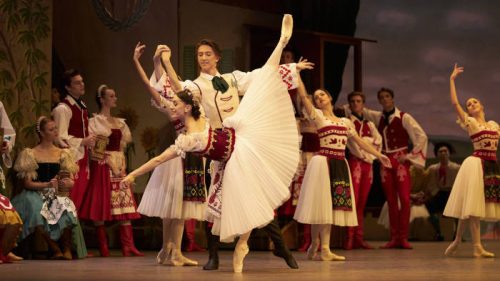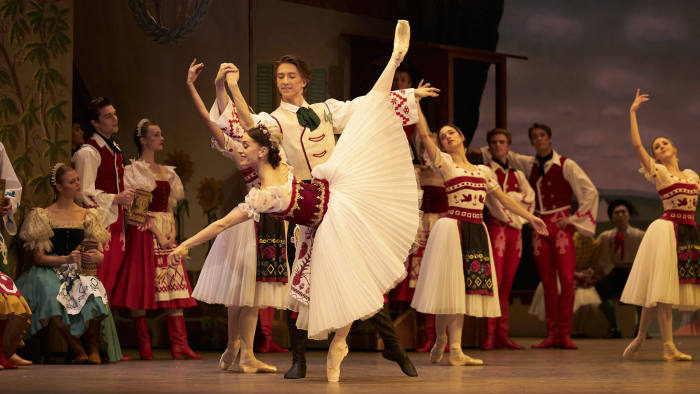 United Kingdom The Royal Ballet’s Coppélia: Dancers of The Royal Ballet, Orchestra of the Royal Opera House / Barry Wordsworth (conductor). Directed for the screen by Ross MacGibbon and broadcast live from the Royal Opera House to Cineworld Basildon, Essex, 10.12.2019. (JPr)
United Kingdom The Royal Ballet’s Coppélia: Dancers of The Royal Ballet, Orchestra of the Royal Opera House / Barry Wordsworth (conductor). Directed for the screen by Ross MacGibbon and broadcast live from the Royal Opera House to Cineworld Basildon, Essex, 10.12.2019. (JPr)

Production:
Choreography – Ninette de Valois after Lev Ivanov and Enrico Cecchetti
Music – Léo Delibes
Scenario – Charles Nuitter and Arthur Saint-Léon
Designer – Osbert Lancaster
Lighting designer – John B. Read
Cast included:
Swanilda – Marianela Núñez
Franz – Vadim Muntagirov
Dr Coppélius – Gary Avis
Swanilda’s friends – Mica Bradbury, Isabella Gasparini, Hannah Grennell, Meaghan Grace Hinkis, Romany Pajdak, Leticia Stock
Aurora – Claire Calvert
Prayer – Annette Buvoli
The Royal Ballet has revived its venerable production of Coppélia for the first time since 2006 and it has led to a stunning company achievement, full of technical accomplishment, bravura dancing, and boisterous ensembles. Performed like this Coppélia vies with Frederick Ashton’s La Fille mal gardée as the most charming and light-hearted of all ballets. It was created in Paris in 1870 and Dame Ninette de Valois’s 1954 production is now as old as I am! As a senior citizen – though someone who has never really grown up – for once there were some watching this live relay at the Cineworld Basildon who were actually younger than me. It made a noticeable change from the ‘grey generation’ – of which I am clearly one – that seem to be the only ones who regular go to these ballets (or operas) shown there.
The story is slight: there is to be a festival in an Austrian village at which all engaged couples will receive a gift of money from the Duke. Swanilda is the fiancée of Franz, a handsome young villager. On the eve of their wedding she has cause to doubt the seriousness of his affections when he is seen flirting with a beautiful girl sitting on the balcony of eccentric Dr Coppélius’s house. After a bucolic Act I, the second act has Swanilda and her six playful companions investigate Coppélius’s house and she dresses as the doll and pretends to come to life. This act ends with the complete humiliation of the aged inventor. Act III basically is just a succession of divertissements for the blessing of a bell and the dances represent the different reasons the bell can be tolled, such as, Dawn and Prayer – here just part of Swanilda and Franz’s wedding celebrations. At the end of the ballet, Coppélius is still something of an outsider but has been placated by the Duke’s money.
Coppélia is based on an original E.T.A. Hoffmann story called The Sandman otherwise better known for the Olympia doll act of Jacques Offenbach’s 1881 The Tales of Hoffmann. Here another ‘hero’ also becomes obsessed with a realistic-looking figure that a crazy scientist and toymaker has made and has the urge to get to know ‘her’ better. In the ballet much jealousy ensues between Swanilda and the fickle Franz over the doll. Depending on the production, the ballet can take a more sinister turn as Coppélius tries to transfer the ‘life-force’ – Dr Frankenstein-like – from a drugged Franz to his creation in the second act, but Ninette de Valois – or ‘Madam’ – somewhat glosses over this in her version despite Coppélius’s attempts at magic spells.
Coppélia is also the near-perfect antidote to all the tragic, bad, or even fake, news in a sometimes cruel and too often dispiriting world. However there was plenty of tragedy following the 1870 première of this sunniest of works as within a few months its choreographer, Arthur Saint-Léon, was dead, as was the first Coppélius and – even more sadly – the 16-year-old ballerina, the first Swanilda, Giuseppina Bazzacchi, had died of smallpox. As if this was not enough, the Franco-Prussian war began and would soon close Paris’s Théâtre Impérial de l’Opéra where the ballet was first put on. Nevertheless, Coppélia has survived in a thread that remains unbroken from those first performances to the present day.
This highlights the magnificence and the problem with ballet: it is fantastic – as here – to see such a splendid re-creation of a masterpiece but ‘re-creation’ essentially is all it is. Whilst appreciating what we are seeing, we must also pay homage to those who came before. The original choreographer gave in to the fashion in Western Europe at the time for a woman to appear en travesti as Franz. As time went on this caused a problem as Léo Delibes wrote no music for a formal pas de deux and Franz’s musical themes proved rather lightweight for male dancers down the subsequent years. (In a backstage interview conductor Barry Wordsworth explained how the current reordered score was at least all Delibes.) Modern productions are based on Lev Ivanov and Enrico Cecchetti’s 1894 Moscow revival of Marius Petipa’s original choreography. Given the talent of the current generation of dancers there is much pretty dancing on show but not too much that really challenges them. With an energetic gallop this Coppélia – like most versions – just fizzles out after the grand pas de deux as Swanilda forgives Franz and their marriage is celebrated.
Osbert Lancaster’s delightful stage pictures provide a storybook setting which has the look of a typical olde worlde central European village full of happy, smiling peasants, in their delightfully embroidered dirndls or other impossibly colourful costumes.
Barry Wordsworth and the Orchestra of the Royal Opera House seemed to relish Delibes’s effervescent score – not only the concluding gallop, but the earlier mazurka and heel-clicking czardas – and the playing sounded better than it sometimes can for a ballet performance. With the utmost respect to those concerned, I was present in years gone by when any old musical rubbish would do as long as the dancing was spectacular, but this is rarely the case now and there are usually the highest standards of music performance. On this occasion – as heard through cinema loudspeakers – there was some excellent playing with several sublime solo contributions.
Coppélia has a slight plot but still requires a lot of mime and this is well performed by all concerned. In Ross MacGibbon’s closeup direction for the screen it was a such a pleasure to see even the dancers at the very back of the stage never dropping out of character and rarely losing the sense of joy in their faces. Throughout the entire ballet, acting and movement were perfectly integrated by an ensemble who were at the top of their form. Franz knows his power over ladies and Vadim Muntagirov gave one the very best performances I have seen from this great dancer. He was a very convincing young tearaway, so it is a pity that he has relatively little to do and spends most of Act II zonked out at Coppélius’s table! There was brio in every step Muntagirov did and the vitality of his dancing turbocharged the virtuosity of his set-pieces in Act III. By turns Muntagirov was courteous, flirtatious, or revealed a twinkling sense of fun. He was an equally accomplished and sensitive partner to the truly magnificent Marianela Núñez who was the most perfect, funny and feisty, Swanilda imaginable. The chemistry between the two leads was so believable that I felt Swanilda and Franz’s bickering transcended the artificiality of ballet.
Núñez is an accomplished actor-dancer able to convey the full gamut of Swanilda’s emotions, whether playfulness, love or jealously. She gives the same care and attention to all her steps whether they are simple or complicated ones. It was as if Núñez was giving a masterclass to those on stage with her and my spirits lifted with each of her variations as she perfectly captured the light, humorous quality of the work, with her formidable technique, grace, rock-steady balances and precise footwork. The Royal Ballet have cast eight Swanildas in their current run of performances, but I doubt any will be as good as Núñez.
All Swanilda’s friends (Mica Bradbury, Isabella Gasparini, Hannah Grennell, Meaghan Grace Hinkis, Romany Pajdak, and Leticia Stock) deserve a mention for their impeccable contributions in Act I and especially in Coppélius’s workroom in Act II which could hardly be bettered. Claire Calvert was a radiant Dawn and a final individual mention goes to Gary Avis for his nuanced portrayal of Dr Coppélius, even though he could have been a little less avuncular and more like the Child Catcher (from Chitty Chitty Bang Bang). Avis’s Coppélius suffered the insults of some mischievous villagers with great stoicism and brought great pathos to his cradling of the lifeless doll at the end of Act II.
Jim Pritchard
